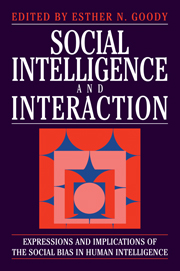 Social Intelligence and Interaction
Social Intelligence and Interaction Book contents
- Frontmatter
- Contents
- List of contributors
- Conventions used in transcripts
- Preface
- Introduction: some implications of a social origin of intelligence
- Part I Primary processes
- Part II The interactive negotiation of meaning in conversation
- Part III Genres as tools that shape interation
- 7 Politeness strategies and the attribution of intentions: the case of Tzeltal irony
- 8 Interaction planning and intersubjective adjustment of perspectives by communicative genres
- Part IV Expressions of a social bias in intelligence
- Consolidated bibliography
- Index
7 - Politeness strategies and the attribution of intentions: the case of Tzeltal irony
Published online by Cambridge University Press: 09 January 2010
- Frontmatter
- Contents
- List of contributors
- Conventions used in transcripts
- Preface
- Introduction: some implications of a social origin of intelligence
- Part I Primary processes
- Part II The interactive negotiation of meaning in conversation
- Part III Genres as tools that shape interation
- 7 Politeness strategies and the attribution of intentions: the case of Tzeltal irony
- 8 Interaction planning and intersubjective adjustment of perspectives by communicative genres
- Part IV Expressions of a social bias in intelligence
- Consolidated bibliography
- Index
Summary
In this chapter I want to take up the idea that human thinking is systematically biased in the direction of interactive thinking (E. Goody's anticipatory interactive planning, or AIP), that humans are peculiarly good at, and inordinately prone to, attributing intentions and goals to one another (as well as to non-humans), and that they routinely orient to presumptions about each other's intentions in what they say and do. I want to explore the implications of that idea for an understanding of politeness in interaction. I shall take as a starting point the Brown and Levinson model of politeness, which assumes interactive thinking, a notion implicit in the formulation of politeness as strategic orientation to face.
Brown and Levinson (1978, 1987) have proposed a model of politeness wherein human actors are endowed with two essential attributes: face and rationality. We claim that face consists of two specific kinds of wants: positive face (i.e., the desire to be approved of, admired, liked, validated), and negative face (the desire to be unimpeded in one's actions). The second ingredient in our model is rationality, the ability to reason from communicative goals to linguistic means that would achieve those goals. From these two assumptions – face and rationality – and the assumption that speakers universally mutually know that all speakers have these attributes, we developed a model of how speakers construct polite utterances in different contexts on the basis of assessments of three social factors: the relative power (P) of speaker and addressee, their social distance (D), and the intrinsic ranking (R) of the face-threateningness of an imposition.
- Type
- Chapter
- Information
- Social Intelligence and InteractionExpressions and implications of the social bias in human intelligence, pp. 153 - 174Publisher: Cambridge University PressPrint publication year: 1995
- 16
- Cited by


